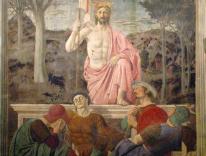At the Pray Tell blog, Nathan Chase has a practical question: what do you do when your worship space is "too big" for the number of people gathered to worship in it?
His question takes for granted that it is desirable to have the members of the assembly at Mass sit (or stand) reasonably close together, and I think he's right about that. I like a little elbow room as much as the next Catholic, but it has certainly been my experience that I feel most connected to my fellow Massgoers when they are within reach. And I think being connected to each other is a crucial dimension of the liturgy. It also seems to encourage vocal participation (singing, answering prayers, etc.). If the sign of peace comes and I can't reach a single person (outside of my family) to shake hands, I wonder, am I really part of an intentional assembly, or are we just a lot of strangers who happened to show up in the same place at the same time for Mass?
Becoming aware of that dynamic has encouraged me to make a conscious effort, when I go to Mass, to get closer to the people I'm praying with. It seems to me we should relate to fellow parishioners differently than we relate to random strangers we encounter in public. So, I've tried to overcome my inclination to steer well clear of others, as if I were choosing a seat in a doctor's waiting room, and instead opt for, say, a pew near the front that already has a couple of people in it instead of an empty one near the back. I'm not getting so close that it makes people uncomfortable. Just close enough that I can't forget they're there, too.
I also try not to park myself on the aisle, blocking easy access to the rest of an otherwise empty pew. I'm always astonished at how many people do exactly that. Commuters know it's poor etiquette on the train or bus to force other people to ask your permission to sit in the seat you've blocked. Some people still do it, but when the train is full enough, people will ask them to move, because it's less awkward than having to stand (which, on a rush-hour train, always makes me wonder, Why bother with the passive-aggressive seat-hog act in the first place? But I digress). Since churches seldom fill to capacity, people (at least in my experience) seldom ask the aisle-seat-takers to move, and the result is a lot of pews left mostly empty but for the very ends, all the way back.
What can be done to avoid antisocial seating patterns at what ought to be a reasonably social celebration? Chase mentions a few ideas. The best solution, I suppose, is for people who attend the same Mass regularly to get to know each other -- if Massgoers are not strangers, they're less likely to behave like they are. But that's a long-term project, and of course there will always be visitors. Another possibility: have someone get up, before Mass starts, and invite people to move in closer to the altar and to each other. This kind of thing has to be done right -- it has to be genuinely welcoming, not scolding (nothing like this). The goal is not making people feel bad about the seat they've chosen, but inviting them to take an even better one. The only place I've seen this done was in Florence, Italy, at the Duomo. This happened twice, on two different visits three years apart: a sacristan -- the same fellow, both times -- came out before the Sunday Mass began to welcome us all and ask us to please move in closer. He did this in Italian, but his warm manner made his meaning clear. I ended up sitting inside the rail that encloses the altar (visible here), next to the credence table, and close enough to offer the sign of peace to tourists from a number of different countries. The experience of intimacy was not at all what I'd expected from Mass in such a venerable and cavernous space, especially as a tourist, but I've never forgotten it, and I've often wished more churches could pull it off.
What's it like at your parish? How would you fix this problem? Or do you prefer to maintain a decorous football field's distance between you and the next sinner?
Please email comments to [email protected] and join the conversation on our Facebook page.
Previous Story
Welcome? Francis! 2
Next Story
What Counts as "Unjust Discrimination"?
